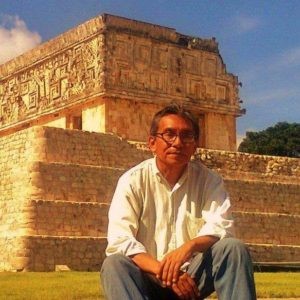The definitive conquest of the Maya by the Spanish was a long process that lasted more than a century and a half, 170 years to be exact, even though the heyday and splendor of the ancient Maya had already ended, and they were in a period of decline.
That year, 1527 -when Francisco de Montejo el Adelantado arrived to the eastern coast of the Yucatan Peninsula-, to 1697 -when Tayasal, the last Mayan city, located on an island in the middle of Lake Petén Itzá in Guatemala-, fell, unlike the conquest of the Aztec Empire that succumbed in only two years, from 1519 when Hernán Cortés arrived to the Yucatan Peninsula, to 1521 when Tenochtitlán fell under his command.
The Mayan civilization occupying a vast region, developed over a wide area of Central America and Mexico.
The ancient Mayans knew of the existence of Europeans as early as 1502, ten years after the arrival of Christopher Columbus to the American continent, when Bartolomé Colón, brother of Admiral Christopher Columbus, found himself in the Gulf of Honduras, which at the time was an unknown region to the Spanish, with some canoes of Mayan merchants.
In later years, several Spanish explorers passed off the coast of the Yucatan but did not enter these lands. In 1511 the first Iberians arrived, but shipwrecked, when the soldier Gonzalo Guerrero, former priest Geronimo de Aguilar and other companions of his, reached the Mayan coasts after the shipwreck of their galleon in the middle of the Caribbean Sea. However, the only real survivors were Guerrero and Aguilar, who were left as Slaves of two Mayan rulers, since the others were sacrificed by indigenous priests.
There were many reasons why the Spanish conquest of the pre-Hispanic Maya took so long. Some of them were:
- Francisco de Montejo, el Adelantado’s unfamiliarity with the region.
- The political organization of the Mayas in autonomous provinces, that is, the absence of a central power, a kingdom or an empire, as in the case of the Aztecs.
- The actions of Gonzalo Guerrero, the shipwrecked Spanish soldier who became a Mayan when he married the daughter of the “cacique” to whom he served as a slave, and was then captain of that ruler’s armies and advised the other indigenous leaders militarily in the defense of their territory, against their former Spanish compatriots. (We will talk about him next week)
- The definitive establishment of the first important Spanish political settlement, as the capital of the territory to be conquered, was the city of Merida, in 1542, in charge of Francisco de Montejo “El Mozo”, son of the Adelantado, fifteen years after the arrival of the European conquerors to the Mayan area.
In the long process of the establishment of the Spanish dominion, the Adelantado founded and ordered to establish, in diverse places of the Yucatan Peninsula eight cities with the name of Salamanca, probably in honor of the city where apparently he was born.
However, today only a few of these sites maintain the category of city, but none of them retain the title of Salamanca. Those places were:
- Xelhá, in Quintana Roo, 1527
- Xamanhá, the present city of Playa del Carmen, 1528
- Xicalango, in Tabasco 1529
- Itzankanac, in Campeche 1529
- The site where the city of Campeche is today, 1531
- Champoton, in Campeche, 1537
- The place where today is the city of Chetumal, Quintana Roo, 1542
- Bacalar, in Quintana Roo, 1545
The conquest of the Mayas is full of stories, battles and fantastic events worthy being mentioned and narrated, which we will also present in later articles.
For The Yucatan Times
Indalecio Cardeña Vázquez
Mérida, Yucatán, 24 de enero de 2020.
 Indalecio Cardeña Vázquez. – Anthropologist, researcher and writer.
Indalecio Cardeña Vázquez. – Anthropologist, researcher and writer.
He has collaborated with the “Unidad Yucatán de la Dirección de Culturas Populares”, Instituto Nacional Indigenista and was the director of the Pinacoteca “Juan Gamboa Guzmán” of the INAH
Among his anthropological works are the iconographic analysis of the colonial sacred art of the Yucatan Peninsula; the symbolisms in the facade of Conquistador Montejo’s house, in Mérida; the Mayan symbolism in the Yucatan Cathedral and the archaeoastronomy among the Mayans.
Professor Cardeña has written several books and articles since the mid 1980’s to this date.



